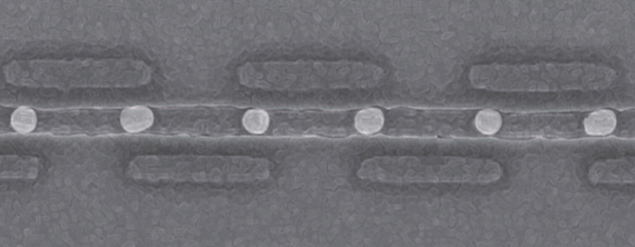
Disorder at work: the Josephson junction quantum simulator
A theory that describes how quantum particles interact with each other in 1D has been put to the test by two independent teams of physicists. In one experiment, aspects of the Tomonaga–Luttinger theory were verified using laser-trapped ultracold atoms. The other study made use of superconducting devices. Confirmation of the theory could lead to the development of new technologies based on nanowires and other 1D systems. Applications include electronics, sensing, energy harvesting and quantum information.
Tomonaga–Luttinger theory describes a 1D ensemble of interacting quantum particles in terms of a Tomonaga–Luttinger liquid (TLL). It predicts properties of 1D quantum systems such as how electrons behave in a nanowire. Testing these predictions in a systematic way has not been possible, however, because it is very difficult to control how particles interact in 1D systems such as nanowires.
Quantum simulator
One way forward is to create an analogous quantum system such as an ensemble of trapped ultracold atoms, in which parameters such as particle interactions can be controlled. While there has been some progress in studying TLLs using quantum simulators, challenges remain. One problem is that a TLL has a homogenous distribution of particles whereas most quantum simulators have spatial order. Ultracold atoms, for example, are held in a 1D lattice with regular spacing.
Now, Bin Yang, Yang-Yang Chen and colleagues at the University of Science and Technology of China have overcome this inhomogeneity problem in an ultracold-atom simulator. Their experiment begins with a regular 1D array of rubidium-87 atoms trapped in an optical lattice of laser light. A laser pulse is then used to eject atoms from the central region of the trap, which sets off a density wave that moves outwards from the centre of the trap. The atomic density in the central region of the trap becomes nearly uniform, thus providing a homogeneous analogue to a TLL.
TLL parameter
By measuring the density and speed of sound in the central region, the team could work out the “TLL parameter” – which measures the level of quantum fluctuations in the system. Yang, Chen and colleagues then measured the momentum distribution in the system and confirmed that it was as predicted by the TTL model.
Meanwhile at the University of New South Wales, Timothy Duty and colleagues took a very different approach. They made their quantum simulators using lines of superconducting material that are interrupted by Josephson junctions at intervals of about 1 μm. In this case, the quantum particles are the Cooper pairs of electrons that are responsible for superconductivity.
Disorder versus interactions
Josephson junctions are non-superconducting regions through which the Cooper pairs can tunnel. There is inherent disorder in the materials used to make simulators and this results in slight differences in the number of Cooper pairs at each junction. By studying simulators with different sized junctions – and therefore different levels of disorder – Duty and colleagues were able to look at how disorder and particle interactions compete against each other to determine the properties of the TLL. When interactions dominate, for example, the system behaved as a superfluid. But when disorder prevails, the system became glass-like with no flow.
https://physicsworld.com/a/atoms-and-josephson-junctions-simulate-1d-quantum-liquid/